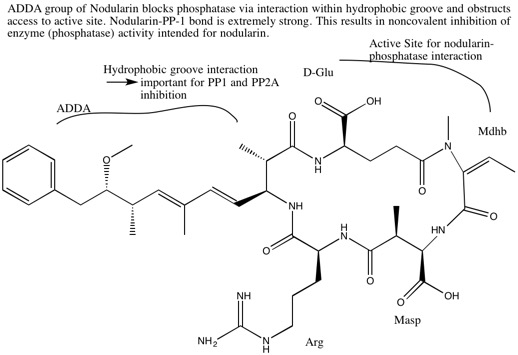|
Cyclic Peptide
Cyclic peptides are polypeptide chains which contain a circular sequence of bonds. This can be through a connection between the amino and carboxyl ends of the peptide, for example in cyclosporin; a connection between the amino end and a side chain, for example in bacitracin; the carboxyl end and a side chain, for example in colistin; or two side chains or more complicated arrangements, for example in amanitin. Many cyclic peptides have been discovered in nature and many others have been synthesized in the laboratory. Their length ranges from just two amino acid residues to hundreds. In nature they are frequently antimicrobial or toxic; in medicine they have various applications, for example as antibiotics and immunosuppressive agents. Thin-Layer Chromatography (TLC) is a convenient method to detect cyclic peptides in crude extract from bio-mass. Classification Cyclic peptides can be classified according to the types of bonds that comprise the ring. *Homodetic cyclic peptides, suc ... [...More Info...] [...Related Items...] OR: [Wikipedia] [Google] [Baidu] |
Oxytocin
Oxytocin (Oxt or OT) is a peptide hormone and neuropeptide normally produced in the hypothalamus and released by the posterior pituitary. It plays a role in social bonding, reproduction, childbirth, and the period after childbirth. Oxytocin is released into the bloodstream as a hormone in response to sexual activity and during labour. It is also available in pharmaceutical form. In either form, oxytocin stimulates uterine contractions to speed up the process of childbirth. In its natural form, it also plays a role in bonding with the baby and milk production. Production and secretion of oxytocin is controlled by a positive feedback mechanism, where its initial release stimulates production and release of further oxytocin. For example, when oxytocin is released during a contraction of the uterus at the start of childbirth, this stimulates production and release of more oxytocin and an increase in the intensity and frequency of contractions. This process compounds in intensity ... [...More Info...] [...Related Items...] OR: [Wikipedia] [Google] [Baidu] |
Pristinamycin
Pristinamycin ( INN), also spelled pristinamycine, is an antibiotic used primarily in the treatment of staphylococcal infections, and to a lesser extent streptococcal infections. It is a streptogramin group antibiotic, similar to virginiamycin, derived from the bacterium '' Streptomyces pristinaespiralis''. It is marketed in Europe by Sanofi-Aventis under the trade name Pyostacine. Pristinamycin is a mixture of two components that have a synergistic antibacterial action. Pristinamycin IA is a macrolide, and results in pristinamycin's having a similar spectrum of action to erythromycin. Pristinamycin IIA (streptogramin A) is a depsipeptide. PI and PII are coproduced by ''S. pristinaespiralis'' in a ratio of 30:70. Each compound binds to the bacterial 50 S ribosomal subunit and inhibits the elongation process of the protein synthesis, thereby exhibiting only a moderate bacteriostatic activity. However, the combination of both substances acts synergistically and leads to a potent b ... [...More Info...] [...Related Items...] OR: [Wikipedia] [Google] [Baidu] |
Polymyxin B
Polymyxin B, sold under the brand name Poly-Rx among others, is an antibiotic used to treat meningitis, pneumonia, sepsis, and urinary tract infections. While it is useful for many Gram negative infections, it is not useful for Gram positive infections. It can be given by injection into a vein, muscle, or cerebrospinal fluid or inhaled. The injectable form is generally only used if other options are not available. It is also available as the combinations bacitracin/polymyxin B and neomycin/polymyxin B/bacitracin for use on the skin. Common side effects when given by injection include kidney problems, neurological problems, fever, itchiness, and rash. Injections into muscle may result in significant pain. Other serious side effects may include fungal infections, anaphylaxis, and muscle weakness. It is unclear if use during pregnancy is safe for the baby. Polymyxin B works by breaking down the cytoplasmic membrane which generally results in bacterial cell death. Polymyxin B wa ... [...More Info...] [...Related Items...] OR: [Wikipedia] [Google] [Baidu] |
Octreotide
Octreotide, sold under the brand name Sandostatin among others, is an octapeptide that mimics natural somatostatin pharmacologically, though it is a more potent inhibitor of growth hormone, glucagon, and insulin than the natural hormone. It was first synthesized in 1979 by the chemist Wilfried Bauer, and binds predominantly to the somatostatin receptors SSTR2 and SSTR5. It was approved for use in the United States in 1988. Octreotide (Mycapssa) was approved for medical use in the European Union in 2022. , octreotide (Mycapssa) is the first and only oral somatostatin analog (SSA) approved by the FDA. Medical uses Tumors Octreotide is used for the treatment of growth hormone producing tumors ( acromegaly and gigantism), when surgery is contraindicated, pituitary tumors that secrete thyroid-stimulating hormone (thyrotropinomata), diarrhea and flushing episodes associated with carcinoid syndrome, and diarrhea in people with vasoactive intestinal peptide-secreting tumors (VIPomas) ... [...More Info...] [...Related Items...] OR: [Wikipedia] [Google] [Baidu] |
Nodularin
Nodularins are potent toxins produced by the cyanobacterium ''Nodularia spumigena'', among others. This aquatic, photosynthetic cyanobacterium forms visible colonies that present as algal blooms in brackish water bodies throughout the world. The late summer blooms of ''Nodularia spumigena'' are among the largest cyanobacterial mass occurrences in the world. Cyanobacteria are composed of many toxic substances, most notably of microcystins and nodularins: the two are not easily differentiated. A significant homology of structure and function exists between the two, and microcystins have been studied in greater detail. Because of this, facts from microcystins are often extended to nodularins. Nodularin-R is the predominant toxin variant, though 10 variants of nodularin have been discovered to date. Nodularins are cyclic nonribosomal pentapeptides and contain several unusual non-proteinogenic amino acids such as N-methyl-didehydroaminobutyric acid and the β-amino acid ADDA. These c ... [...More Info...] [...Related Items...] OR: [Wikipedia] [Google] [Baidu] |
Nisin
Nisin is a polycyclic antibacterial peptide produced by the bacterium ''Lactococcus lactis'' that is used as a food preservative. It has 34 amino acid residues, including the uncommon amino acids lanthionine (Lan), methyllanthionine (MeLan), didehydroalanine (Dha), and didehydroaminobutyric acid (Dhb). These unusual amino acids are introduced by posttranslational modification of the precursor peptide. In these reactions a ribosomally synthesized 57-mer is converted to the final peptide. The unsaturated amino acids originate from serine and threonine, and the enzyme-catalysed addition of cysteine residues to the didehydro amino acids result in the multiple (5) thioether bridges. Subtilin and epidermin are related to nisin. All are members of a class of molecules known as lantibiotics. In the food industry, nisin is obtained from the culturing of ''L. lactis'' on natural substrates, such as milk or dextrose, and it is not chemically synthesized. It was originally isolated in ... [...More Info...] [...Related Items...] OR: [Wikipedia] [Google] [Baidu] |
Microcystins
Microcystins—or cyanoginosins—are a class of toxins produced by certain freshwater cyanobacteria, commonly known as blue-green algae. Over 250 different microcystins have been discovered so far, of which microcystin-LR is the most common. Chemically they are cyclic heptapeptides produced through nonribosomal peptide synthases. Cyanobacteria can produce microcystins in large quantities during algal blooms which then pose a major threat to drinking and irrigation water supplies, and the environment at large. Characteristics Microcystins—or cyanoginosins—are a class of toxins produced by certain freshwater cyanobacteria; primarily ''Microcystis aeruginosa'' but also other ''Microcystis'', as well as members of the ''Planktothrix'', ''Anabaena'', ''Oscillatoria'' and ''Nostoc'' genera. Over 250 different microcystins have been discovered so far, of which microcystin-LR is the most common. Chemically they are cyclic heptapeptides produced through nonribosomal peptide synthas ... [...More Info...] [...Related Items...] OR: [Wikipedia] [Google] [Baidu] |
Hymenistatin
Hymenistatin is a cyclic peptide isolated from the sea sponge Sponges, the members of the phylum Porifera (; meaning 'pore bearer'), are a basal animal clade as a sister of the diploblasts. They are multicellular organisms that have bodies full of pores and channels allowing water to circulate through th ... '' Phakellia fusca''. It is a cyclic octapeptide whose sequence is cyclo le-Ile-Pro-Pro-Tyr-Val-Pro-Leu References Cyclic peptides {{organic-compound-stub ... [...More Info...] [...Related Items...] OR: [Wikipedia] [Google] [Baidu] |
Gramicidin S
Gramicidin S or Gramicidin Soviet is an antibiotic that is effective against some gram-positive and gram-negative bacteria as well as some fungi. It is a derivative of gramicidin, produced by the gram-positive bacterium ''Brevibacillus brevis''. Gramicidin S is a cyclodecapeptide, constructed as two identical pentapeptides joined head to tail, formally written as ''cyclo''(- Val-Orn- Leu-D- Phe-Pro-)2. That is to say, it forms a ring structure composed of five different amino acids, each one used twice within the structure. Another interesting point is that it utilizes two amino acids uncommon in peptides: ornithine as well as the atypical stereoisomer of phenylalanine. It is synthesized by gramicidin S synthetase. Biosynthesis Gramicidin S biosynthetic pathway consists of two-enzyme of nonribosomal peptide synthases ( NRPSs), gramicidin S synthetase I (GrsA) and gramicidin S synthetase II (GrsB), to give a product as a cyclic decapeptide. Within the biosynthetic pathway, th ... [...More Info...] [...Related Items...] OR: [Wikipedia] [Google] [Baidu] |
Daptomycin
Daptomycin, sold under the brand name Cubicin among others, is a lipopeptide antibiotic used in the treatment of systemic and life-threatening infections caused by Gram-positive organisms. Daptomycin was removed from the World Health Organization's List of Essential Medicines in 2019. The World Health Organization classifies daptomycin as critically important for human medicine. Medical uses In the United States, daptomycin is indicated for use in adults for skin and skin structure infections caused by Gram-positive infections, ''S. aureus'' bacteraemia, and right-sided ''S. aureus'' endocarditis. It binds avidly to pulmonary surfactant, so cannot be used in the treatment of pneumonia. There seems to be a difference in working daptomycin on hematogenous pneumonia. Adverse effects Common adverse drug reactions associated with daptomycin therapy include: *Cardiovascular: low blood pressure, high blood pressure, swelling *Central nervous system: insomnia *Dermatological: ra ... [...More Info...] [...Related Items...] OR: [Wikipedia] [Google] [Baidu] |
Dactinomycin
Dactinomycin, also known as actinomycin D, is a chemotherapy medication used to treat a number of types of cancer. This includes Wilms tumor, rhabdomyosarcoma, Ewing's sarcoma, trophoblastic neoplasm, testicular cancer, and certain types of ovarian cancer. It is given by injection into a vein. Most people develop side effects. Common side effects include bone marrow suppression, vomiting, mouth ulcers, hair loss, liver problems, infections, and muscle pains. Other serious side effects include future cancers, allergic reactions, and tissue death at the site of injection. Use in pregnancy may harm the baby. Dactinomycin is in the cytotoxic antibiotic family of medications. It is believed to work by blocking the creation of RNA. Dactinomycin was approved for medical use in the United States in 1964. It is on the World Health Organization's List of Essential Medicines. Medical use Actinomycin is a clear, yellowish liquid administered intravenously and most commonly used in tre ... [...More Info...] [...Related Items...] OR: [Wikipedia] [Google] [Baidu] |




